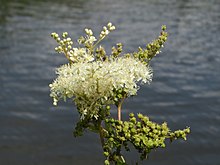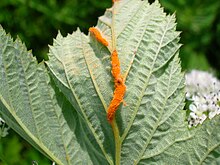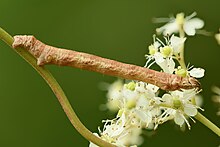Filipendula ulmaria
| Meadowsweet | |
|---|---|

| |
| Scientific classification | |
| Kingdom: | Plantae |
| Clade: | Tracheophytes |
| Clade: | Angiosperms |
| Clade: | Eudicots |
| Clade: | Rosids |
| Order: | Rosales |
| Family: | Rosaceae |
| Genus: | Filipendula |
| Species: | F. ulmaria
|
| Binomial name | |
| Filipendula ulmaria | |
Filipendula ulmaria, commonly known as meadowsweet[1] or mead wort,[2] is a perennial herbaceous plant in the family Rosaceae that grows in damp meadows. It is native throughout most of Europe and Western Asia (Near East and Middle East). It has been introduced and naturalised in North America.
Meadowsweet has also been referred to as queen of the meadow,[1] pride of the meadow, meadow-wort, meadow queen, lady of the meadow, dollof, meadsweet, and bridewort.
Description[edit]

The stems, growing up to 120 cm, are 1–2 m (3.3–6.6 ft) tall, erect and furrowed, reddish to sometimes purple. The leaves are dark-green on the upper side and whitish and downy underneath, much divided, interruptedly pinnate, having a few large serrate leaflets and small intermediate ones. Terminal leaflets are large, 4–8 cm long, and three- to five-lobed.
Meadowsweet has delicate, graceful, creamy-white flowers clustered close together in irregularly-branched cymes, having a very strong, sweet smell redolent of antiseptic.[3] They flower from early summer to early autumn and are visited by various types of insects, in particular Musca flies.[4]
The flowers are small and numerous, they show 5 sepals and 5 petals with 7 to 20 stamens.[5]
Diseases[edit]
Many insects and fungi cause disease in meadowsweet.[6]

Meadowsweet leaves are commonly galled by the bright orange-rust fungus Triphragmium ulmariae, which creates swellings and distortions on the stalk and/or midrib.[7]
The fungus Ramularia ulmariae causes purple blotches on the leaves.
The fungus Podosphaera filipendulae causes mildew on the leaves and flower heads, coating them with a white powder.[8]
The midge Dasineura ulmaria causes pinkish-white galls on the leaves that can distort the leaf surface.[9]
Etymology[edit]
The English common name meadowsweet dates from the 16th century. It did not originally mean 'sweet plant of the meadow', but a plant used for sweetening or flavouring mead. An earlier common name dating from the 15th century was 'meadsweet'.[10]
Meadowsweet is known by many other names. In Chaucer's The Knight's Tale it is known as meadwort and was one of the ingredients in a drink called "save".[11] It was also known as bridewort, because it was strewn in churches for festivals and weddings, and often made into bridal garlands. In Europe, it took its name "queen of the meadow" for the way it can dominate a low-lying, damp meadow.
The specific epithet ulmaria means "elmlike", possibly in reference to its individual leaves which resemble those of the elm (Ulmus). The generic name, Filipendula, comes from filum, meaning "thread" and pendulus, meaning "hanging". This is said to describe the slender attachment of root tubers, which hang characteristically on the genus, on fibrous roots.[12]
Synonyms[edit]
Filipendula denudata (J.Presl & C.Presl) Fritsch[13]
Distribution[edit]


Meadowsweet is common throughout the British Isles[5] in damp areas and is dominant in fens and wet woods.[14][15]
Juncus subnodulosus-Cirsium palustre fen-meadow and purple moor grass and rush pastures BAP habitat plant associations of Western Europe consistently include this plant.[16]
Uses[edit]
The whole herb possesses a pleasant taste and flavour, the green parts having a similar aromatic character to the flowers, hence the use of the plant as a strewing herb, strewn on floors to give the rooms a pleasant aroma, and its use to flavour wine, beer, and many kinds of vinegar. The flowers can be added to stewed fruit and jams, giving them a subtle almond flavour. Some foragers also use the flowers to flavour desserts such as panna cotta. It has many medicinal properties. The whole plant is a traditional remedy for an acidic stomach. The dried flowers are used in potpourri. It is also a frequently used spice in Scandinavian varieties of mead.
Chemical constituents include salicin, flavone glycosides, essential oils, and tannins. In 1838, Raffaele Piria obtained salicylic acid from the buds of meadowsweet.[17] Thereafter in 1899, scientists at the firm Bayer used salicylic acid derived from meadowsweet to synthesise acetylsalicylic acid (aspirin), which was named after the old botanical name for meadowsweet, Spiraea ulmaria. The name then became aspirin.[18]
A natural black dye can be obtained from the roots by using a copper mordant.
A tea made from Filipendula ulmaria flowers or leaves has been used in traditional Austrian herbal medicine for the treatment of rheumatism, gout, infections, and fever.[19]
Culture[edit]
White-flowered meadowsweet has been found with the cremated remains of three people and at least one animal in a Bronze Age cairn at Fan Foel, Carmarthenshire. Similar finds have also been found inside a beaker from Ashgrove, Fife,[20] and a vessel from North Mains, Strathallan. These could indicate mead or flavoured ale, or might suggest that the plant was placed on the grave as a scented flower.[21]
In Welsh mythology, Gwydion and Math created a woman out of oak blossom, broom, and meadowsweet and named her Blodeuwedd ("flower face").
In the 16th century, when it was customary to strew floors with rushes and herbs (both to give warmth underfoot and to overcome smells and infections), it was a favorite of Elizabeth I of England. She desired it above all other herbs in her chambers.[11]
References[edit]
- ^ a b "Filipendula ulmaria". Germplasm Resources Information Network. Agricultural Research Service, United States Department of Agriculture. Retrieved 12 December 2017.
- ^ Richard Chandler Alexander Prior (1863). On the popular names of British plants: being an explanation of the origin and meaning of the names of our indigenous and most commonly cultivated species. Williams and Norgate.
- ^ Poland J, Clement EJ. 2020. The Vegetative Key to the British Flora. John Poland, Southampton, Second Edition. ISBN 978-0-9560-1442-9
- ^ Van Der Kooi, C. J.; Pen, I.; Staal, M.; Stavenga, D. G.; Elzenga, J. T. M. (2015). "Competition for pollinators and intra-communal spectral dissimilarity of flowers". Plant Biology. 18 (1): 56–62. doi:10.1111/plb.12328. PMID 25754608.
- ^ a b Parnell, J. and Curtis, T. 2012. Webb's An Irish Flora. Cork University Press. ISBN 978-185918-4783
- ^ Ellis, Willem N. "Filipendula ulmaria meadowsweet". Plant Parasites of Europe leafminers, galls and fungi. Retrieved 5 August 2020.
- ^ Ericson, L.; Burdon, J. J.; Müller, W. J. (2002). "The Rust Pathogen Triphragmium ulmariae as a Selective Force Affecting Its Host, Filipendula ulmaria". Journal of Ecology. 90 (1): 167–178. doi:10.1046/j.0022-0477.2001.00648.x. ISSN 0022-0477. JSTOR 3072329. S2CID 84898900.
- ^ Ellis, Willem N. "Podosphaera filipendulae (Zhao) Liu & Braun, 2010". Plant Parasites of Europe - leafminers, galls and fungi. Retrieved 5 August 2020.
- ^ Nijveldt, W. 1969. Gall Midges of Economic Importance. Vol. 8. London: Crosby Lockwood.
- ^ Grigson G. 1974. A Dictionary of English Plant Names. Allen Lane. ISBN 0-71-390442-9
- ^ a b Mount T. 2015. Dragon Blood & Willow Bark. The Mysteries of Medieval Medicine. Amberley Publishing Limited ISBN 1-44-564383-9
- ^ Gledhill D. 1985. The Names of Plants. Cambridge University Press ISBN 978-0-5213-6675-5
- ^ "Filipendula denudata (J.Presl & C.Presl) Fritsch". www.worldfloraonline.org. Retrieved 22 January 2021.
- ^ Clapham, A.R., Tutin, T.G. and Warburg, E. F. 1973. Excursion Flora of the British Isles. Cambridge University Press. ISBN 0-521-04656-4
- ^ Hackney, P. (Ed) 1992. Stewart and Corry's Flora of the North-east of Ireland. Institute of Irish Studies and the Queen's University of Belfast. ISBN 0-85389-446-9
- ^ C. Michael Hogan. 2009. Marsh Thistle: Cirsium palustre, GlobalTwitcher.com, ed. N. Strömberg "Marsh Thistle (Cirsium palustre ) - photo/Images/Information - GlobalTwitcher.com". Archived from the original on December 13, 2012. Retrieved August 3, 2010.
- ^ Bandurska H. 2013. Salicylic acid: an update on biosynthesis and action in plant response to water deficit and performance under drought. In: Salicylic acid (pp. 1-14). Springer, Dordrecht
- ^ Ansari MS, Misra N. 2007. Miraculous role of salicylic acid in plant and animal system. American Journal of Plant Physiology 2(1): 51 - 58.
- ^ Vogl S, Picker P, Mihaly-Bison J, Fakhrudin N, Atanasov AG, Heiss EH, Wawrosch C, Reznicek G, Dirsch VM, Saukel J, and Kopp B. 2013. Ethnopharmacological in vitro studies on Austria's folk medicine — An unexplored lore in vitro anti-inflammatory activities of 71 Austrian traditional herbal drugs. Journal of Ethnopharmacology 149(3): 750 - 771.
- ^ "myADS" (PDF). Archaeology Data Service. Retrieved 2016-12-15.
- ^ M. Pitts (2006). Meadowsweet flowers in prehistoric graves. British Archaeology 88 (May/June): 6
- Neltje Blanchan (2002). Wild Flowers: An Aid to Knowledge of our Wild Flowers and their Insect Visitors. Project Gutenberg Literary Archive Foundation.
External links[edit]
![]() Media related to Filipendula ulmaria at Wikimedia Commons
Media related to Filipendula ulmaria at Wikimedia Commons
